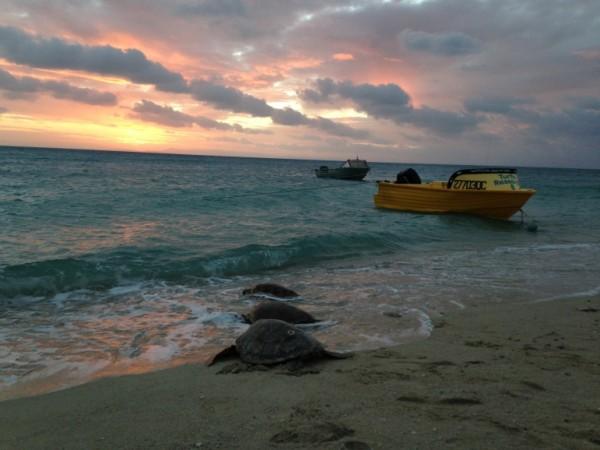
Sex chromosomes have nothing to do with how green sea turtles develop into males or females. It's the heat of sand incubating their eggs that determines the sex of a growing embryo, with warmer temperatures resulting in more females.
This unique biological trait of these creatures is what that has jeopardised their future in an increasingly warmer world as rising temperatures due to climate change are turning one of the world's largest sea turtle colonies almost entirely female, a new study revealed.
At the pivot temperature of 29.3 degrees Celsius (85 Fahrenheit), green sea turtles hatch as a mixture of males and females. If the temperature drops a few degrees below that mark, all the sea turtles are born male. And, if the eggs get heated up, only females are born.
Over the past two decades, temperatures on islands in Australia's northern Great Barrier Reef have increased to the point "that virtually no male turtles are now being produced from these nesting beaches," researchers from the United States and Australia said in the study, published in the journal Current Biology on Monday.
"This is extreme—like capital letters extreme, exclamation point extreme," Camryn Allen, a National Oceanic and Atmospheric Administration (NOAA) endocrinology researcher and the study's co-author, told National Geographic. "We're talking a handful of males to hundreds and hundreds of females. We were shocked."

Although scientists previously knew that warming temperatures alter the sex of sea turtle offspring, the new study is the first detailed look with direct documentation of the trend in a major wild population. The results also raise new questions about the risks for marine turtles worldwide, as well as other temperature-dependent species including alligators and iguanas.
Unlike anatomical exams at nesting beaches used to determine the sex of individual hatchlings, the new study used an innovative combination of endocrinology and genetics to assess the sex of hundreds of turtles across a large foraging ground.
The analysis revealed that green sea turtles from cooler southern nesting beaches were about 65 to 69 percent female. Majority of sea turtles from warmer northern beaches, on the other hand, were female, with 86.8 percent of adult turtles, 99.8 percent of sub-adult turtles and 99.1 percent of juvenile turtles turning out to be female.
"The disconcerting thing is that we can now see how changes in the climate could affect the longevity of this and other sea turtle populations around the world," Michael Jensen, NOAA marine biologist and the study's lead author, said in a statement.
According to researchers, the increasing number of females is not the problem for sea turtle populations as it could, in fact, boost their reproductive potential. The actual trouble is associated with the fact that these turtles have not been able to adjust to the fast changing modern climate.
"The pace of change affecting these populations is probably unlike anything they have experienced before," Allen said in the statement. "We know that species evolve in response to climate and other environmental changes, but they need time for that. Unfortunately in this case, that may be one thing they do not have."





!['Lip lock, pressure, pyaar': Vidya Balan- Pratik Gandhi shine in non-judgmental infidelity romcom Do Aur Do Pyaar [ Review]](https://data1.ibtimes.co.in/en/full/797104/lip-lock-pressure-pyaar-vidya-balan-pratik-gandhi-shine-non-judgmental-infidelity-romcom.jpg?w=220&h=138)







